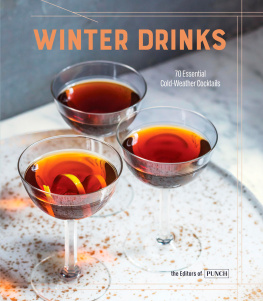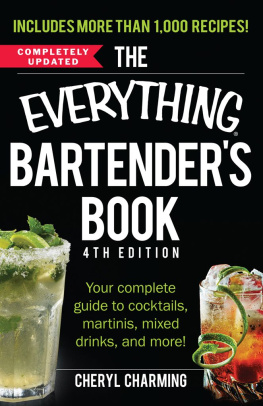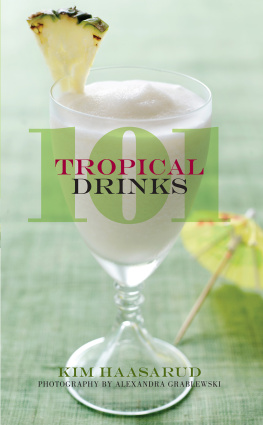Contents
ACKNOWLEDGMENTS
Thank you, firstly, to all of the bartenders who have graciously allowed us to feature their recipes on PUNCH and inspired our own drink-making in these pages. Audrey Sanders, Erik Adkins, Jamie Boudreau, Leo Robitschek, Damon Boelte, Sam Ross, Dan Sabo, Ryan Fitzgerald, Natasha David, Brad Ferran, Lucinda Sterling, the staff at Diamond Reef, Jason Kosmas, Jon Santer, Phil Ward, Brad Thomas Parsons, Adam Seger, Sother Teague, Gabriel Orta, Elad Zvi, Chris Hannah, Henry Pendergast, Andrew Volk, Isaac Shumway, Dan Greenbaum, Karen Fu, Joaqun Sim, Richard Boccato, Simone Goldberg, the staff at the Dead Rabbit, Tom Macy, Alla Lapushchik, Chantal Tseng, William Elliott, Jacob Grier, Erick Castro, Karin Stanley, Joe Campanale, Brian Bartels, Kathleen Hawkins, this is for all of you.
Thank you to Julie Bennett and Anne Goldberg from Ten Speed Press for shepherding this project along with grace, kindness, and patience. To Margaux Keres, the books designer and prop stylist, for schlepping across the country and between dozens of Ubers to make this happen. To Emma Campion for her guidance and savvy, always. To the entire production team at Ten Speed Press. To Ricky Agustin for being the biggest badass there ever was and for styling all of the drinks for every shoot like a proand, more importantly, for having the best attitude in the room while doing it (and it wasnt always easy). To the teams at Rider, Freemans, and Faun for letting us invade your beautiful restaurants and make complete messes of them. We owe you times infinity.
And, lastly, thank you to winter for inspiring us to fortify ourselves against you. This is for you, too.
PUNCH is a Brooklyn-based, James Beard Awardwinning online magazine devoted to narrative journalism about wine, spirits, beer, and cocktails.
ANATOMY OF A WINTER COCKTAIL
What is a nog, really ? Questions featuring this kind of existential prodding are of great concern to us at PUNCH. You are what you drink, after all. Although its not absolutely crucial to understand the ins and outs of every cocktail in history to whip up a winter drink, its a useful starting point if you aim to get creative on your own. So, first things first: know your nogs from your glggs and your sours from your smashes. Heres a quick guide to the main cocktail families and their more esoteric winter brethren.
CLASSIC COCKTAIL FAMILIES
Most of the cocktail canons classic and modern drinks fit into these ten categories.
Cocktail
While the word cocktail has become synonymous with mixed drink, it actually refers to a style of drink: a simple combination of spirit, sweetener (generally sugar or sugar syrup), water, and bitters. The old-fashioned is the archetype. Today, we also use this category to refer to the drinks that rely on this formula with the addition of either vermouth or liqueursthink Manhattan, martini, and Negroni.
Sour
These are drinks made with a base spirit, fresh citrus, and a sweetener (again, generally sugar or a sugar syrup). The most classic example is the daiquiri. A subcategory of the sour is the daisy, which refers to the same formula but with a liqueur (or grenadine) in place of, or in addition to, sugar or sugar syrup. The margarita and the sidecar are the icons of this subcategory.
Collins
Your classic collins is basically a sour lengthened with the addition of sparkling water. In this category, no drink looms larger than the Tom Collins, which is a combination of gin, lemon juice, simple syrup, and soda water (i.e., boozy, bubbly lemonade). The collins even has its own namesake glass.
Highball
The highball is a more stripped-down collins. Simply a combination of spirit plus a larger proportion of nonalcoholic mixer, the highball likewise has its own glass, which is a slightly larger, by volume, version of the collins glass. Drinks like the whiskey-ginger, Jack-and-Coke, and scotch-and-soda all fall under the highball umbrella.
Fizz
The fizz is essentially a sour made tall by adding soda waterwhich, of course, sounds exactly like a collins. Theres a debate among cocktail authorities as to how fizzes differ from collins drinks, but there is some consensus that fizzes are shaken and strained, while a collins is built in the glass and stirred. Another difference: fizzes commonly allow the addition of egg white and/or cream (think Ramos gin fizz). In fact, when referring to a fizz drink today, it is often implied that the drink will include one or both additions.
Punch
Punch is not the only drink category to be known primarily by its serveware, but it is certainly the most famous. The flowing bowl, as it were, does in fact have a definition, though it has shape-shifted over the course of its history of nearly four hundred years. Originally it was defined by four or five central ingredients: spirit, citrus, water, sweetener, and, often, spice. That eventually evolved to include the addition of wines like sherry, port, and champagnesometimes all of the above in a single bowl. Today the formula has, like all classic formulas, been updated and refashioned to suit the needs of many a ladle-wielding host.
Cobbler
An offshoot of the punch family tree, a cobbler is, at its most basic, a mix of a spirit or fortified wine, sugar, and fruit, served over crushed ice with a straw. The category is thought to have originated in early nineteenth-century America with the advent of readily available ice. Once considered the height of fashion, the drink largely fell out of favor until the recent cocktail revival. The sherry cobbler remains the categorys primary ambassador, though today you will find cobblers that call on everything from mezcal to amaro.
Julep | Smash
The julep and the smash are both defined by a combination of base spirit, sweetener, crushed ice, and generally lots of mint. Both are among the oldest American cocktail types. Traditionally, the smash was a diminutive julepmeant to be thrown back rather than savoredand was, over the years, rolled under the julep umbrella. Of late, it has roared back to reclaim its place as a drink that is separate, if ill-defined, by modern terms. Today, a smash is often a mixture of a base spirit, sweetener, and muddled mint and citrus, shaken together and served over ice.
Buck | Mule
This family of drinks distinguishes itself by the addition of ginger ale or ginger beer to a base of spirit and citrus, served over ice. The most famous examples of this category is the Moscow Mule, a relatively late addition with an invention date in the 1950s, and the Dark n Stormy, a simple combination of dark rum, lime, and ginger beer.
Sling
A precursor to the original cocktail, the slings of the eighteenth century were nearly interchangeable with the toddy and could be served either hot or cold. By the mid-1800s, the sling was more commonly served cold and the toddy served hot. Add bitters to this formula and voil youve got the original cocktail, the old-fashioned. (A funny historical side note: the most famous drink to bear the sling name, the Singapore sling, is not technically a sling, but a tikified punch.)
CLASSIC WINTER FORMULAS
These drinks and drink types are commonly associated with cold-weather drinking.
Bishop
While the bishop essentially falls under the umbrella of punch, its immortalization in literature (namely, in Dickens A Christmas Carol ) as a symbol of redemption and holiday cheer has helped carve it a niche all its own. A hot drink based on port wine and infused with everything from ginger to cloves to orange peels, the bishop has existed since at least 1755.







